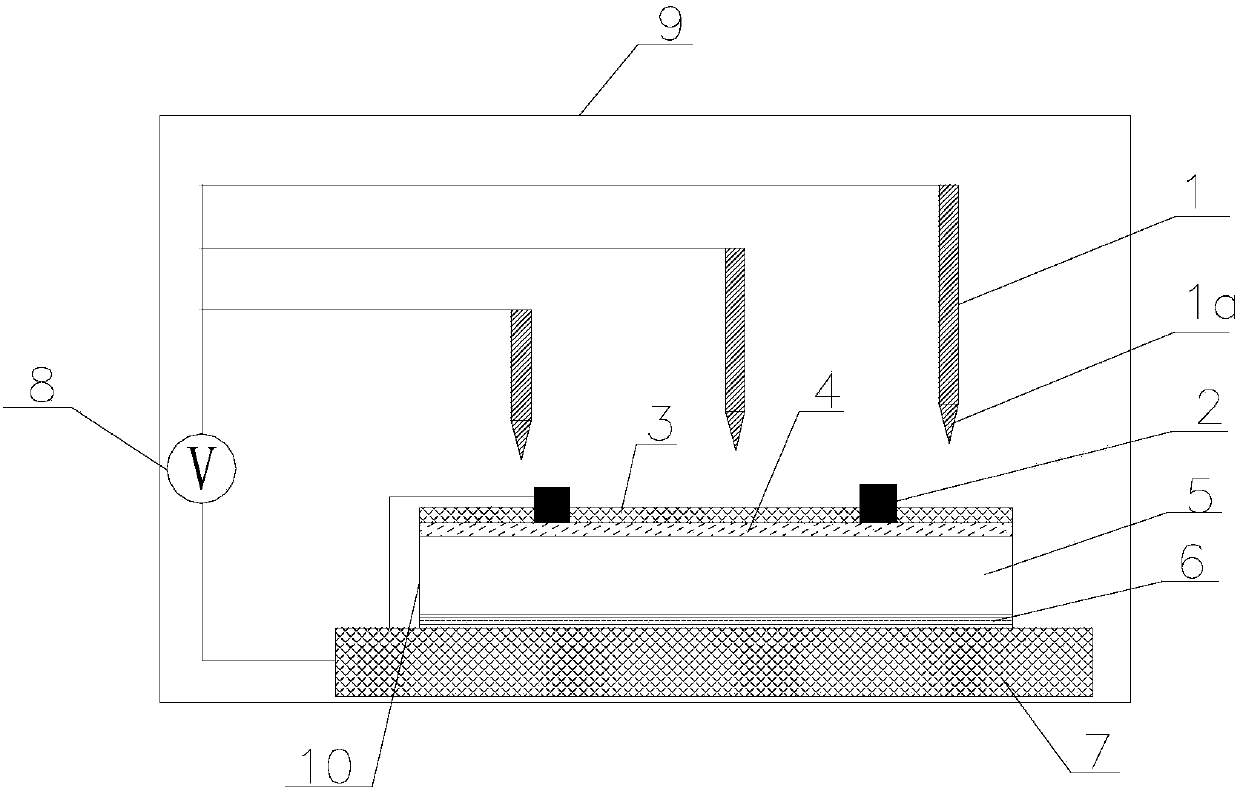A device and method for quickly testing solar cell potential-induced decay
A potential-induced attenuation and solar cell technology, which is applied in photovoltaic power generation, electrical components, photovoltaic system monitoring, etc., can solve the problems of long test period and inflexible test methods, and achieve short test period, shortened test period and accelerated aging speed effect
- Summary
- Abstract
- Description
- Claims
- Application Information
AI Technical Summary
Problems solved by technology
Method used
Image
Examples
Embodiment 1
[0033] Such as figure 1 Shown, the device of rapid test solar cell potential-induced decay of the present invention comprises:
[0034] The environment box 9 has a regulating device for adjusting temperature and humidity in the environment box 9;
[0035] The metal test bench 7 is set in the environmental chamber 9 and the table temperature of the metal test bench can be adjusted; the adjustment method can be electric heating, or a semiconductor temperature control platform. In this embodiment, the metal test bench 7 is a test bench made of metal copper.
[0036] An external power supply 8 can generate a voltage of 200V to 1000V as required; and,
[0037] Several metal probes 1, the metal probes 1 are connected to the external power supply 8 through wires, and the metal probes have pointed ends 11; the metal probes 1 can be one or more, and during the test process, by moving A single or a few metal probes, or directly in the form of a metal probe array, forms a uniformly di...
Embodiment 2
[0041] A kind of method of rapidly testing solar cell potential-induced decay of the present embodiment, comprises the following steps:
[0042] S1: Place the solar cell 10 to be tested on the metal test bench 7 in the environmental chamber 9. The solar cell 10 to be tested has: a front electrode 2, an antireflection film 3, an emitter 4, and a silicon substrate 5 and the back electrode 6;
[0043] S2: adjust the temperature of the table top of the metal test bench 7 to 25°C, adjust the humidity in the environmental chamber to 30%, conduct a J-V test and an EL test on the solar cell to be tested, and record the test values;
[0044] S3: Connect the front electrode 2 of the solar cell and the metal test bench 7 with wires, adjust the table temperature of the metal test bench 7 to 90°C, adjust the humidity in the environmental chamber to 90%, and connect the metal probe 1 and the external power supply 8 with wires. It is connected in series with the metal test bench 7 in turn, ...
Embodiment 3
[0049] A kind of method of rapidly testing solar cell potential-induced decay of the present embodiment, comprises the following steps:
[0050] S1: Place the solar cell 10 to be tested on the metal test bench 7 in the environmental chamber 9. The solar cell 10 to be tested has: a front electrode 2, an antireflection film 3, an emitter 4, and a silicon substrate 5 and the back electrode 6;
[0051] S2: adjust the temperature of the table top of the metal test bench 7 to 25°C, adjust the humidity in the environmental chamber to 40%, conduct a J-V test and an EL test on the solar cell to be tested, and record the test values;
[0052] S3: Connect the front electrode 2 of the solar cell and the metal test bench 7 with wires, adjust the table temperature of the metal test bench 7 to 80°C, adjust the humidity in the environmental chamber to 90%, and connect the metal probe 1 and the external power supply 8 with wires. It is connected in series with the metal test bench 7 in sequen...
PUM
 Login to View More
Login to View More Abstract
Description
Claims
Application Information
 Login to View More
Login to View More - R&D
- Intellectual Property
- Life Sciences
- Materials
- Tech Scout
- Unparalleled Data Quality
- Higher Quality Content
- 60% Fewer Hallucinations
Browse by: Latest US Patents, China's latest patents, Technical Efficacy Thesaurus, Application Domain, Technology Topic, Popular Technical Reports.
© 2025 PatSnap. All rights reserved.Legal|Privacy policy|Modern Slavery Act Transparency Statement|Sitemap|About US| Contact US: help@patsnap.com

